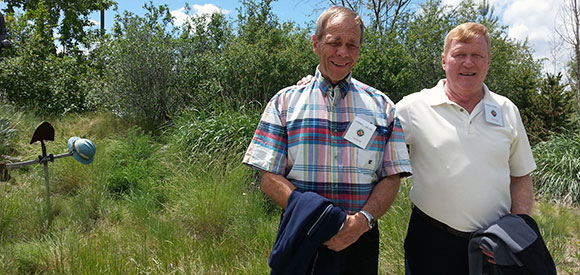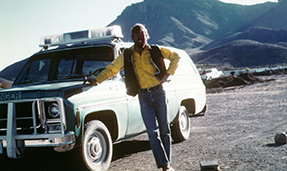When Tony and I first met, structural fire was a slip-on engine and a hope and a prayer and the rangers out there doing what they could. Galen Warren, longtime NPS firefighter and cofounder of the NPS structural fire program
The Birth of the Structural Fire Program

There are always those who have walked the fireground before us. What they learned for the first time is now common knowledge. Tools they invented are now as common as a blue sky in the southwestern United States. It was in the National Park Service Southwest (SW) Region, as it was known at the time, where the NPS Structural Fire Training Program began.
To capture and record the stories of this program’s birth, Tony Bacon and Galen Warren traveled to Boise to take part in an oral history project. These two firefighters, old friends and founding fathers, had not seen each other for many years. Once they were in a room together, we turned on the video camera, and sat back and enjoyed their reflections of the early days of the program. What follows is a bit more about them, and some of the highlights of their conversation.
Tony Bacon: A firefighter and training officer for the Novato Fire District in California. He is a stickler for teaching to standards and keeps safety as a top priority.
Galen Warren: An Air Force firefighter and fire investigator hired by the NPS in 1976 at the SW Regional office in Santa Fe, New Mexico, as a safety technician. He puts safety at the forefront and saw a need and opportunity to build the foundation for a future NPS Structural Fire Training Program.
“When Tony and I first met, structural fire was a slip-on engine (Type 6) and a hope and a prayer and the rangers out there doing what they could,” recalled Galen Warren. It was at the New Mexico State Fire Academy he introduced himself to Tony Bacon, who was teaching ventilation. Galen also remembers admiring Tony’s “little attack pumper.”
Their synergy would be unstoppable.
Two years later, Tony and Galen were driving back from teaching a structural fire class in Big Bend National Park. Galen was not surprised when Tony said, “We can’t just do what we’ve been doing. There has to be levels of training. What are the basic requirements? Who is going to direct all this?”
Galen, desperately wanted to put something on paper to launch a training program, at a minimum, for the Southwest Region. He started to outline what the structure fire training program could look like. They decided on a curriculum and wrote the Southwest regional policy for structural fire that day. This policy would eventually be adopted by all the regions and became national policy in 1987.
Bill Orr from the Seasonal Ranger Academy in Santa Rosa, California, called Tony. “We want you to come down and give a little orientation to fire,” Bill said.
Tony’s response was, “Well, what do you want me to teach about fire exactly?”
“Just teach ‘em about fire,” Bill responded.
Tony recalls that the training “ended up being a weekend thing.” The students learned how to use hose out of the hose box, hydrants, and a lot of basics such as fire behavior, first aid, and other assorted odds and ends. “Just enough to keep yourself out of trouble and maybe keep someone else from getting hurt,” said Tony. Tony continued, “Galen did the hard stuff. He continually politicked to make people stand up and take notice that structural fire training mattered.”
As their banter continued, Galen said that ”Tony did the real work,” recalling how Tony would scrounge equipment and personal protective equipment (PPE) from his fire department, box it up, and send it down to the training site. When the park didn’t have anything, he would borrow nozzles, packing them up in his suitcase. Parks would call and say, “We don’t have any equipment. And we don’t have any hose either.” In the early days, Tony would frequently teach with Galen on his vacation time or days off, often as a volunteer. Days were rarely shorter than 12 hours. Sometimes, the two pros would sleep in hammocks in the fire department engine bay because there was no money for training, let alone hotel rooms. Their dedication to changing the way the parks, and park rangers, approached structural firefighting was effort that was well spent.
Many buildings in the national parks existed well before the park was established, and in some cases hold the history and stories for why that national park was established. Every building also brings the possibility of fire. Traditionally, it was the park ranger who would spring into action when a fire would occur. Many responded without training or the right equipment. Galen and Tony developed an awareness of the need for training, the curriculum, and the early policy that would become the foundation of change for this high-risk program.
In 1990, Rick Gale at the NPS national office recognized that there needed to be people at the national, regional, and park levels that were dedicated to structural fire safety. Noting the connection between wildland fire and structural fire, funds were allocated to initiate a structural fire program. Jim Farrel was hired as the first structural fire manager, and he was stationed at the National Park Service Fire Management Program Center, located in Boise, Idaho.
During the conversations for the oral history project, Tony noted “Galen and I are only a part of a much bigger story here.” Both Tony and Galen wanted to highlight some of the “movers and shakers that deserve credit for rattling the chains of complacency.” Some of the names they highlighted included Ross Hopkins, Dick Powell, and Chris Cameron, as well as those in the field who provided vital encouragement - Jim Northup (Grand Teton National Park), Bill Wright (Big Bend National Park), Todd Brindle (Guadalupe Mountain National Park), Bob Panko (Everglades National Park), Fred Patten (Canyonlands National Park), Scott Lopez (Ozark National Scenic Riverways), Sammy Lyle (Buffalo National River), Gus Martinez (Padre Island National Seashore), Don Cross (Yosemite National Park), Ray Warren (Sequoia and Kings Canyon National Parks), Hal Spencer, Bill Oswald and Jeff Panetta. “The stories are too numerous to tell.”
In 1980, a young seasonal park ranger took his first structural fire training course at Sleeping Bear Dunes National Lakeshore in Michigan. Collateral duty in structural fire response was mandated for all rangers, running drills on the lawn in front of the visitor center. Many years later, Mark Gorman accepted a job at the Fire Management Program Center in Boise, Idaho, managing the structural fire operations program, which includes structural fire training. Inheriting the rich legacy left by Tony and Galen, he has been an instructor for structural fire for many years, passing the knowledge he first learned from Tony and Galen on to the next generation of NPS structural firefighters and managers.
Want to know what the article title, “Double Doughnuts and Gatorade,” means?
“This was a ‘quip’ we used to acknowledge/praise a squad when a skill was well executed in conjunction with a training assignment. …‘Squad 4 — Double Gatorades’…and doughnuts for the best time in deploying dual attack lines. We had a bunch of these that we used to keep it fun.” —Tony Bacon
Everyone who has had the pleasure of working with Tony Bacon over the years refers to sayings like these as “Bacon Bits.”
A Short Biography about Tony Bacon
Tony began his 26-year fire service career with the Novato, California Fire Protection District and served to the position of battalion chief.
While serving with district, he was assigned as a division supervisor with Nor Cal Interagency Incident Management Team No. 2 and was also assigned to the California Department of Forestry and Fire Protection’s Firescope Curriculum Development Task Force. As an instructor with the California State Fire Service Training and Education System, he earned his Lifetime Teaching Credential from the University of California and instructed at various community colleges throughout northern California.
Tony served as president of the Marin–Sonoma Training Officers’ Association and was an active member of the California State Fire Chiefs’–Training Officers’ Northern Section. Tony assisted with development of the National Park Service Structural Fire Training Program and served on National Fire Protection Association Professional Qualifications Standards Committees, as well as with the accreditation committee of the International Fire Service Training Association.
Tony passed away on June 11, 2014. While not an NPS employee, Tony is remembered by many as the father of the NPS structural fire training program. He taught his first formal structural fire suppression class at Lyndon B. Johnson National Historical Park in 1976. Since that time, Tony taught hundreds of classes and provided training to thousands of NPS employees. Several of the courses Tony taught included basic and advanced firefighter training, driver operator, and fire officer.
A Short Biography about Galen Warren

Galen Warren attended Central State University then enlisted in the Air Force and spent two years in Anchorage, Alaska, at Elmendorf Air Force Base from January 1971 through December 1972, serving as a firefighter. After a transfer to McConnell Air Force Base in Wichita, Kansas, he served as a firefighter then as a fire inspector. Galen attended Wichita State University after being discharged from the Air Force and took a job as a fire inspector in the Civil Service for the Department of Defense at McConnell Air Force Base.
In 1976 Galen accepted a position as a risk manager with the National Park Service Regional Office in Santa Fe, New Mexico. In 1991 became the risk manager in Yellowstone National Park and in 1998 transferred to a satellite office of the Rocky Mountain Regional Office in Salt Lake City, Utah. He retired from the National Park Service in 2002.
Last updated: August 21, 2020
